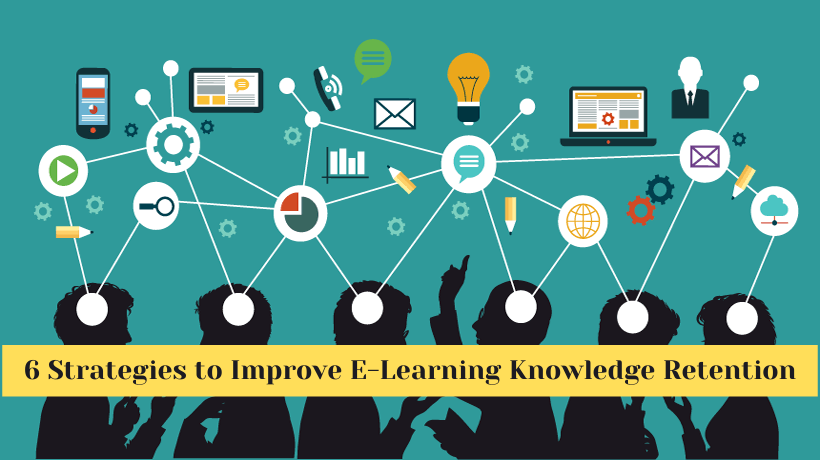6 Strategies to Improve E-Learning Knowledge Retention
When you create an e-learning course or any other type of training material, the aim is to transfer knowledge, enable the use of new skills, and change behaviours. However, according to Gartner, employees apply just 54 percent of the new skills they learn.
This is in an era where technologies and working practices are changing rapidly. For modern UAE and Saudi Arabian businesses, staying competitive means having a future-ready, skills-based workforce. Continuous learning and professional development are central to this, so maximising knowledge retention is crucial.
Knowledge Retention Strategies for E-Learning Content
To get the best results, there should be a specific focus on knowledge retention when creating e-learning courses. The following six strategies help to deepen the learning experience so learners can transfer what they have learned in the course to their day-to-day tasks, actions, and responsibilities.
Create Opportunities to Practice
Practicing is an essential part of learning. This is why on-the-job training can be highly effective, but you can also create opportunities to practice within your e-learning courses. An element of transferring knowledge is important too, but learners should also get the opportunity to practice what they have learned as part of the e-learning experience.
Examples of features and components that you can include in your e-learning course to allow learners to practice include:
- Gamified elements where the learner becomes an active participant in the course.
- Scenarios where you create a situation and ask learners to make decisions, respond, or react.
- Practical tasks, such as going through a workflow in a software application or completing a group task where learners work together.
Make Sure the Content is Relevant
An essential part of maximising knowledge retention is to engage learners as much as possible. It is important that learners understand the benefits they can expect from the new skills or knowledge. It’s also important the content presented to the learner within the course reflects their day-to-day realities.
So, for example, any scenarios that are included should be realistic and relevant to learners.
It is also helpful to include examples and stories within the content of the e-learning course. Examples and stories can make abstract or theoretical concepts real and relatable.
Avoid Cognitive Overload
Our minds can only process so much information at once. That means there is a tipping point, often referred to as cognitive overload. Regardless of how good, engaging, or relevant the content is, it becomes very difficult to retain the knowledge if there is too much information presented to the learner within a short period of time.
Steps you can take to avoid cognitive overload include narrowing the focus of the e-learning course rather than covering too many content areas or topics. In other words, creating multiple e-learning courses rather than trying to get everything into a single course.
Making sure you stay on-topic is also important, as drifting too far from the main focus of the course can lead to a cognitive overload situation.
Embrace Mistakes
In an earlier point, we mentioned the importance of practice in the learning process. Making mistakes is also helpful, as learning from our mistakes is more than a simple cliché.
One of the great things about using e-learning as the delivery method for your training course is that e-learning courses allow learners to make mistakes in a safe environment. Making a mistake in an activity within an e-learning course is not going to put personal safety at risk, for example, or risk damaging customer relationships or corporate reputation.
Develop a Follow-Up Strategy
The training process shouldn’t stop once the learner has completed the e-learning course you have provided. Instead, you should have a follow-up strategy with the aim of improving knowledge retention and, where appropriate, ensuring behavioural change.
A follow-up strategy can include:
- Survey of learners – conducting a survey of learners who have completed your e-learning course can help you make improvements, but surveys are also an opportunity to identify areas where further training support is required.
- Provide information for managers and supervisors – managers and supervisors can help you understand whether learners are applying the new knowledge or skills they have learned. Part of your follow-up strategy could include providing managers with details of the course and the expected outcomes.
- Learner communication – communicating with learners is also helpful. For example, you can provide additional learning resources, information on adjacent topics, and materials the learner can refer back to whenever needed.
- Provide support – make it easy for learners to ask questions and get support.
Offer Recap Courses
Recap courses are typically shorter than the original course and are designed to go over the main topic areas again. Learners are usually asked to complete them a set period of time after they have finished the original course. This could be anything from a couple of months to a year.
Recap courses are not always appropriate, but for complex and high-risk topic areas where regular knowledge and skills reinforcement is required, they can be highly beneficial.
Knowledge Retention is About Getting Results
The best approach to maximise knowledge retention in your e-learning courses is to apply most, if not all, of the strategies outlined above. This will help you achieve the required learning outcomes and maximise return on investment.
